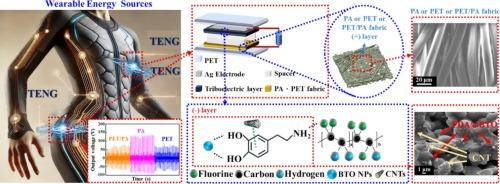High-performance triboelectric nanogenerator based on CNTs/PDA-modified BTO/PVDF nanohybrid films for wearable device applications
IF 7.3
2区 材料科学
Q1 CHEMISTRY, APPLIED
引用次数: 0
Abstract
The growing global demand for energy has driven research into efficient and environment-friendly technologies. Triboelectric nanogenerators (TENGs), which convert mechanical energy into electrical energy, have emerged as a promising solution. TENGs are well-suited for wearable devices and environmental energy harvesting because of their simple structure, light weight, and high adaptability. In this study, tribo-layer films were prepared using the wet-coating method. Carbon nanotubes (CNTs) were incorporated into a polyvinylidene fluoride (PVDF) matrix to form a conductive network that enhances the transfer and collection of triboelectric charges. Electrodes were formed by applying silver paste to the triboelectric nanohybrid films and subsequently used for rubbing against fabric substrates. The top and bottom sections of the device were encapsulated in polyethylene terephthalate to improve structural integrity and durability. Optimal power generation was achieved with a CNT doping concentration of 2 wt%. Barium titanate (BaTiO3, BTO), which has a high dielectric constant, was subsequently introduced into the nanohybrid films. The BTO nanoparticles (NPs) were then surface modified with polydopamine (PDA) to increase compatibility with the PVDF matrix, reduce filler aggregation, and enhance charge trapping. The best output, 126 V, was observed at 5 wt% PDA@BTO doping. Further, this study investigated the triboelectric output characteristics of the developed TENG when combined with different textile materials. CNTs-PDA@BTO/PVDF triboelectric nanohybrid film combined with nylon (PA) fabric (CNTs-PDA@BTO/PVDF TENG) exhibited optimal triboelectric effects, with an output voltage of 140 V. Finally, the optimized CNTs-PDA@BTO/PVDF TENG was integrated into wearable energy harvesting systems, such as power-generating clothing and bicycle seat devices. Simulations of human motion revealed that the TENG achieved sustained power generation under dynamic conditions, with a peak output voltage of 40 V. The results demonstrated that the developed devices demonstrate strong potential for applications in wearable electronics and green energy harvesting.

基于碳纳米管/ pda改性BTO/PVDF纳米杂化膜的可穿戴设备高性能摩擦电纳米发电机
日益增长的全球能源需求推动了对高效和环保技术的研究。将机械能转化为电能的摩擦电纳米发电机(TENGs)已经成为一种很有前途的解决方案。由于其结构简单、重量轻、适应性强,因此非常适合用于可穿戴设备和环境能源收集。本研究采用湿涂法制备了摩擦层薄膜。将碳纳米管(CNTs)掺入聚偏氟乙烯(PVDF)基质中,形成导电网络,增强摩擦电荷的转移和收集。将银糊涂在摩擦电纳米杂化膜上形成电极,然后用于摩擦织物衬底。该装置的顶部和底部用聚对苯二甲酸乙二醇酯封装,以提高结构完整性和耐久性。当碳纳米管掺杂浓度为2 wt%时,发电效果最佳。将具有高介电常数的钛酸钡(BaTiO3, BTO)引入到纳米杂化膜中。然后用聚多巴胺(PDA)对BTO纳米颗粒(NPs)进行表面修饰,以增加与PVDF基质的相容性,减少填料聚集,并增强电荷捕获。当掺杂量为5 wt% PDA@BTO时,输出电压为126 V。此外,本研究还研究了所开发的TENG在与不同纺织材料结合时的摩擦电输出特性。CNTs-PDA@BTO/PVDF摩擦电纳米杂化膜与尼龙(PA)织物(CNTs-PDA@BTO/PVDF TENG)复合后的摩擦电效果最佳,输出电压为140 V。最后,将优化后的CNTs-PDA@BTO/PVDF TENG集成到可穿戴能量收集系统中,如发电服和自行车座椅装置。人体运动模拟表明,TENG在动态条件下实现了持续发电,峰值输出电压为40 V。结果表明,所开发的设备在可穿戴电子产品和绿色能源收集方面具有强大的应用潜力。
本文章由计算机程序翻译,如有差异,请以英文原文为准。
求助全文
约1分钟内获得全文
求助全文
来源期刊

Progress in Organic Coatings
工程技术-材料科学:膜
CiteScore
11.40
自引率
15.20%
发文量
577
审稿时长
48 days
期刊介绍:
The aim of this international journal is to analyse and publicise the progress and current state of knowledge in the field of organic coatings and related materials. The Editors and the Editorial Board members will solicit both review and research papers from academic and industrial scientists who are actively engaged in research and development or, in the case of review papers, have extensive experience in the subject to be reviewed. Unsolicited manuscripts will be accepted if they meet the journal''s requirements. The journal publishes papers dealing with such subjects as:
• Chemical, physical and technological properties of organic coatings and related materials
• Problems and methods of preparation, manufacture and application of these materials
• Performance, testing and analysis.
 求助内容:
求助内容: 应助结果提醒方式:
应助结果提醒方式:


